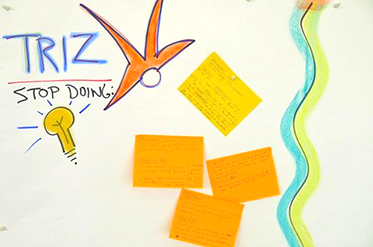TRIZ

Stop counterproductive activities and behaviours to make space for innovation
Overview
TRIZ is a Russian acronym for the Theory of Inventive Problem Solving or Teoriya Resheniya Izobreatatelskikh Zadatch. It poses the provocative question of which actions could lead to the worst possible results. In a relaxed and playful atmosphere, participants acknowledge ineffective activities and habits, leaving space for best practice ideas.
How to use it
- Speak the unspeakable and admit counterproductive methods/behaviours.
- Make space for innovation.
- Lay the ground for creative destruction by doing the hard work in a fun way.
- Before or in place of visioning sessions.
- For leadership groups, “How can we keep doing the same things with the same people and expect different results?”
How to apply it
Setting:
Small groups, in which everyone has an equal opportunity to contribute. First participants work individually, then together.
Materials:
Table or a writing pad to make lists.
Time/Steps:
- 3 segments, approx. 10 minutes for each segment. Use the 1-2-4-All method to structure the group work for each segment.
- With a sly smile, participants are asked, “What can we do to reliably get the worst result imaginable?” They make lists with their top strategies and behaviours.
- Ask participants, “How does this list compare to what we do now?”
- The final segment, ask, “What are the first steps to help us stop what we know creates terrible results?” Discuss strategies in small groups, then everyone together.
How to adapt it
- Go deeper with a second or third round.
- Link these results (creative destruction) to a broad review of activities using the Ecocycle Planning method.
- Share action steps then go deeper and connect the outcome with Troika Consulting or Open Space.
Case study
Title:
Peer review evaluation of project presentations
Activity:
Project cycle management workshop
Contact:
G.Mercier@itcilo.org (SDG)
Description:
The project cycle management workshop is organised twice a year. On the last day of the workshop, the participants traditionally have to present the project they created during the previous days. In the past the facilitator of the workshop used to tell the participants the pitfalls and the success factors of a presentation, “A presentation is not interesting when you do not make eye-contact with your public”, “Having too much text on a slide is not a good idea”, “Use graphs and short sentences”, “Interact”, … However he noticed that this never worked and that all the presentations turned out to be quite boring. This year the facilitator applied the TRIZ method. The day before the presentation he asked the participants to tell him what they could do to make their presentation the worst presentation ever. The participants listed several reasons of a bad presentation, “I should not look at the audience”, “I should talk very fast”… The presentations this year turned out to be very interesting and fun. The participants avoided all the things they had listed themselves.
Tips
- Enter into TRIZ with a spirit of serious fun.
- Don’t accept innovation ideas: be sure suggestions are about stopping activities or behaviours, not starting new things. It is worth the wait.
- Begin with a VERY unwanted result, and quickly confirm the suggestion with the group.
- Check in with groups that are laughing hard or look confused.
- Take time with similarities to what you are doing now and how this harms you.
- Include the people that will be involved in stopping the activities that come out.
- Make real decisions about what will be stopped (number your decisions 1,2,3…)





